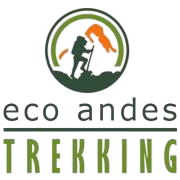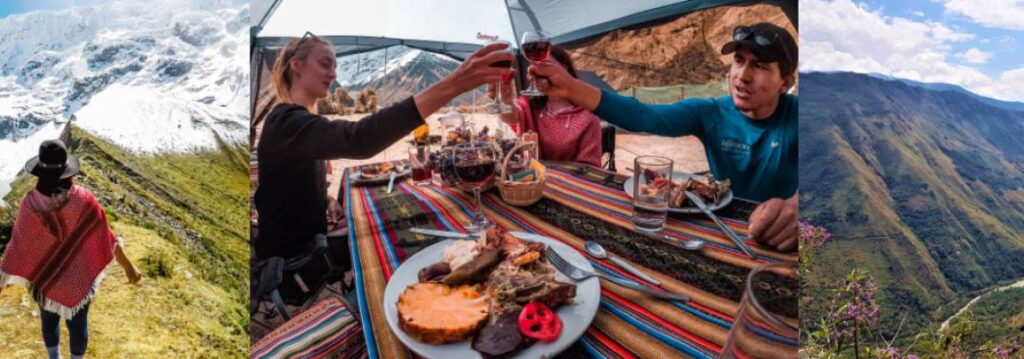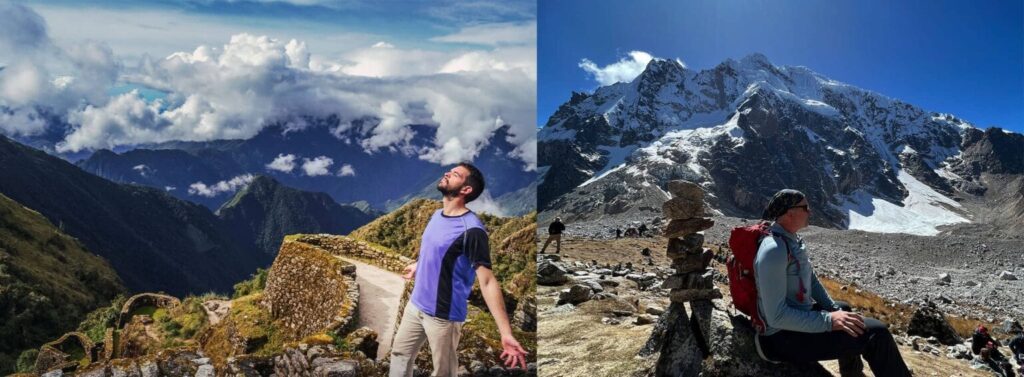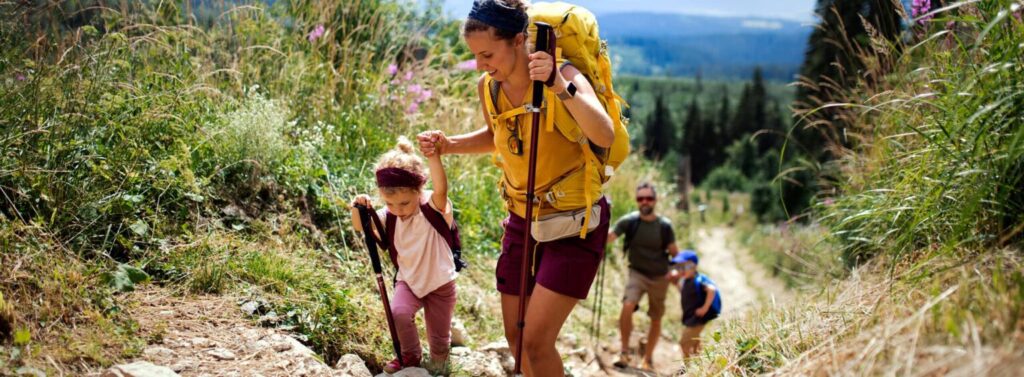
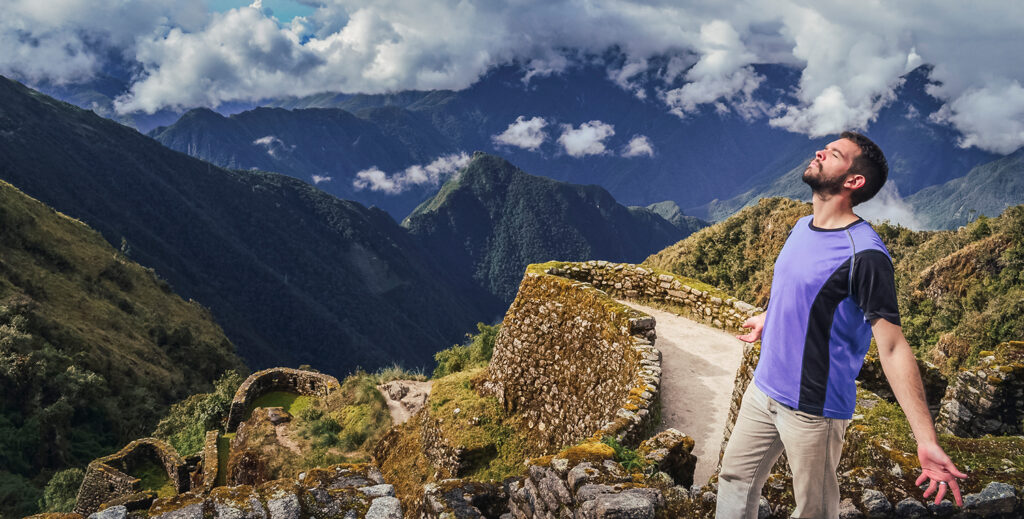
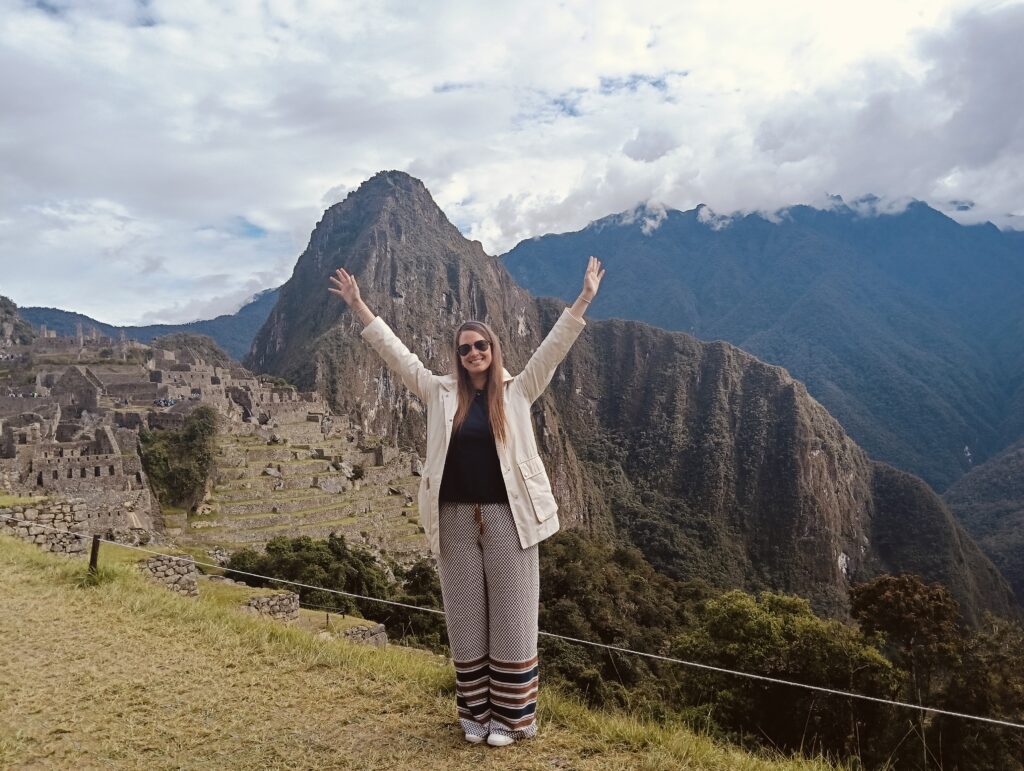
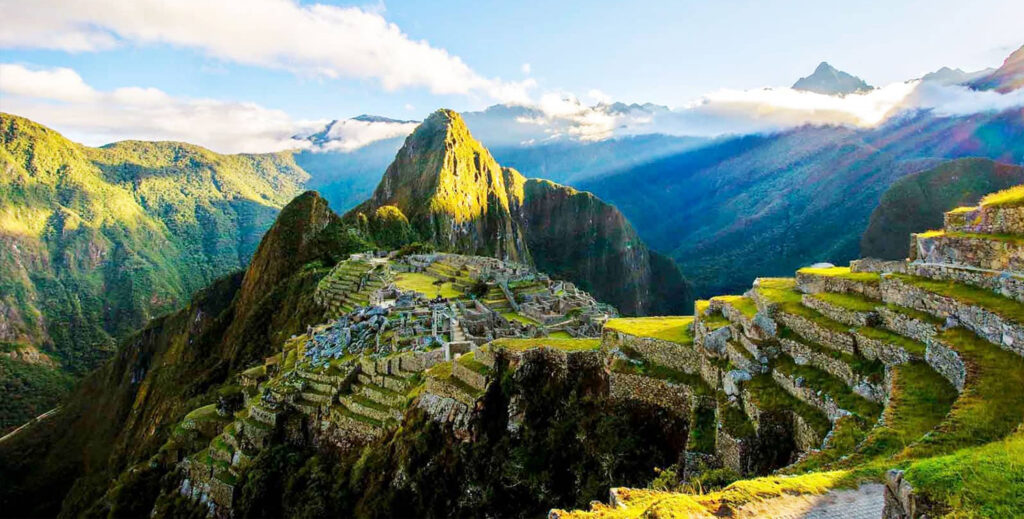
Classic Inca Trail to Machu Picchu – 4D/3N
Embark on our once-in-a-lifetime 4-day Classic Inca Trail Peru Trek to Machu Picchu. Discover ancient ruins, lush landscapes, and cultural wonders. Book now!
Are you ready to push your limits and experience the magic of Machu Picchu in the most authentic way?
Look no further than our Classic Inca Trail trek.
This 4-day, 3-night adventure is designed to challenge your mind, body and spirit while rewarding you with unparalleled views and unforgettable memories.
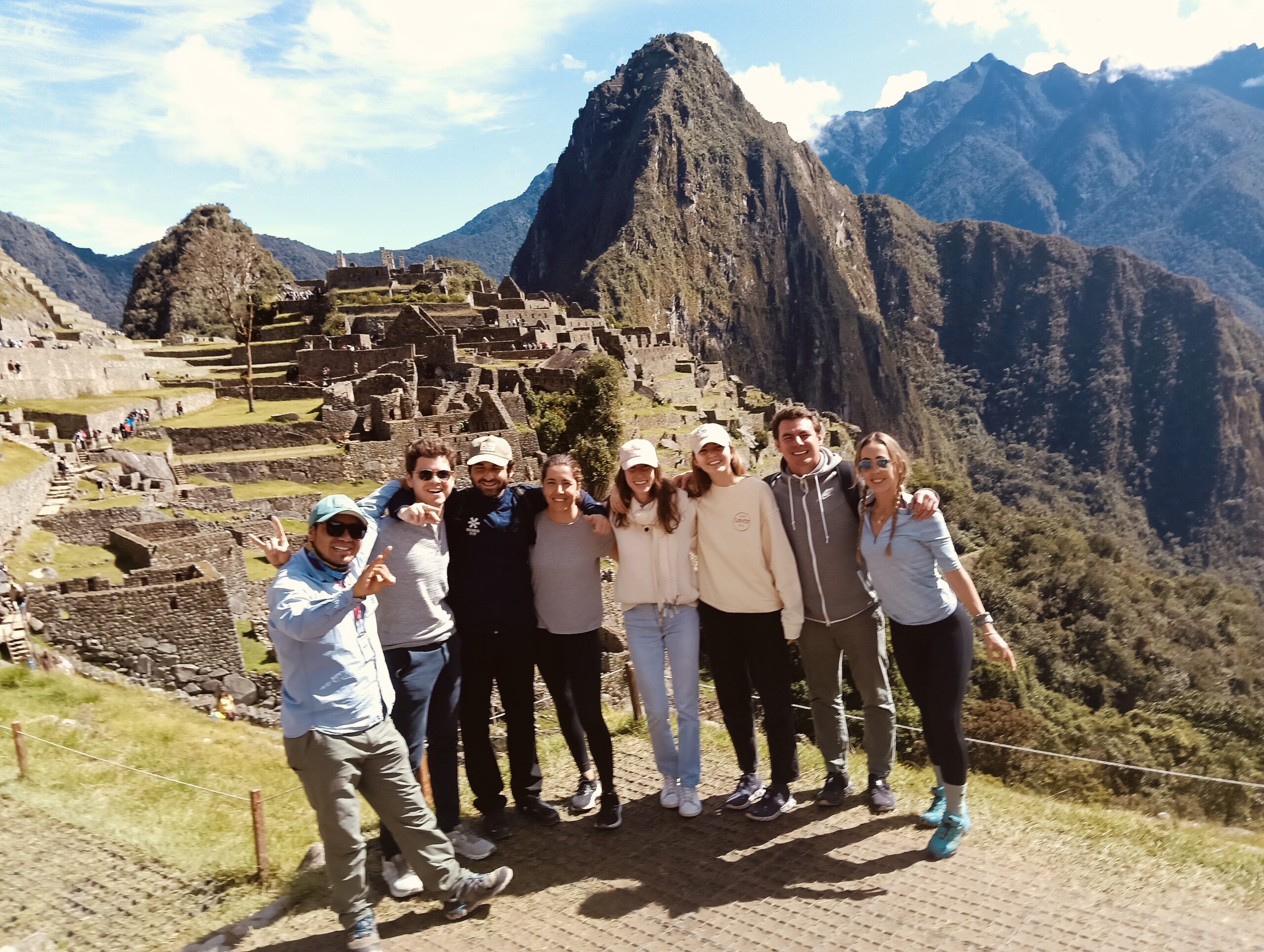
Classic Inca Trail to Machu Picchu – 4D/3N
- Pre-Trek Briefing
- Day 1: Cusco – Trailhead at KM 82 – Ayapata
- Day 2: Ayapata – Dead Woman’s Pass – Pacaymayu – Chaquicocha
- Day 3: Chaquicocha – Phuyupatamarca – Wiñay Wayna
- Day 4: Wiñay Wayna – Sun Gate – Machu Picchu – Cusco
- What’s Included?
- FAQs
About our Classic Inca Trail tour
Ready for the adventure of a lifetime? Conquer the legendary Classic Inca Trail and stand in awe of Machu Picchu – all in just four unforgettable days!
Our 4-day Inca Trail isn’t just about the destination (although Machu Picchu is pretty darn spectacular). It’s about the entire adventure! For four days, you’ll step back in time as you follow the ancient paths carved by the Inca Empire itself.
Each day brings a new challenge and a new wonder. You’ll conquer the legendary Dead Woman’s Pass, explore the fascinating ruins of Phuyupatamarca and Wiñay Wayna, and stand in awe at the Sun Gate (Inti Punku) – your first glimpse of the majestic Machu Picchu rising above the clouds.
This isn’t just a trek; it’s a chance to truly connect with the history and spirit of the Inca people. Our expert guides will bring the ancient world to life, sharing stories and help you to immerse yourself in the magic of Peru’s most iconic wonder “Machu Picchu“.
Looking for an elevated experience? Check out our Premium Inca Trail 5-day trek to Machu Picchu here.
Detailed Itinerary – Classic Inca Trail to Machu Picchu – 4D/3N
Pre-Trek Briefing (required):
Before we set off, we’ll need to discuss what you can expect, cover some ground rules, and, of course, give you an opportunity to ask any questions you have about the itinerary or otherwise.
You can either choose to visit us at our office for this briefing, or we’ll come to you at your hotel.
Note: Your briefing must happen the day before the Inca Trail trek begins, so make sure you give yourself enough time when booking travel over to us!
Day 1: Cusco – Trailhead at KM 82 – Ayapata
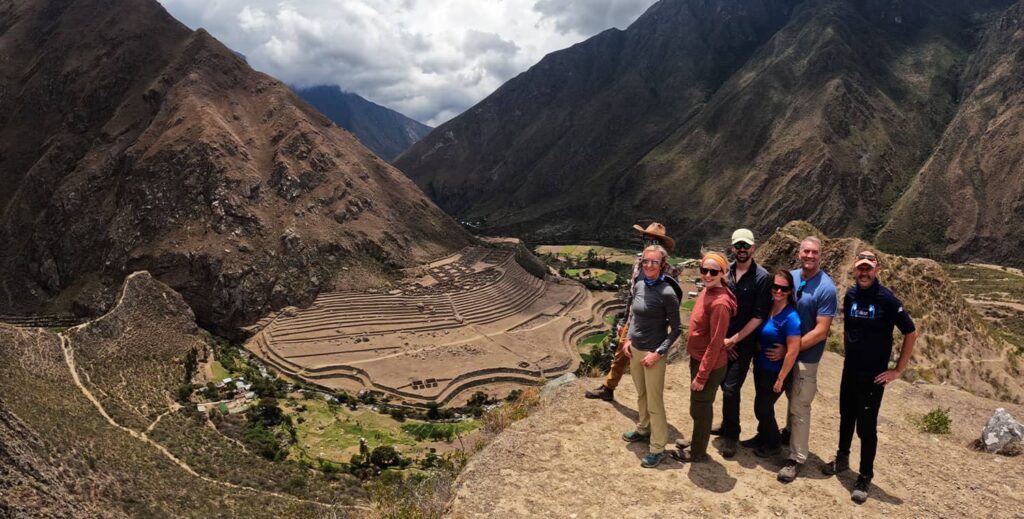
Adventure calls bright and early! Your guide will pick you up from your Cusco hotel at 4:30 am for a scenic drive through the Sacred Valley as the sun rises.
We’ll pause in the bustling market town of Ollantaytambo – a great spot for photos and a delicious breakfast (not included, but plenty of local spots to choose from).
Then, it’s time for the moment you’ve been waiting for: Kilometer 82, where the Classic Inca Trail begins! Here, you’ll meet your dedicated porters, pass through the checkpoint, and embark on your journey.
The first 2.5 hours of trekking will bring you to the Wilkaraqay Inca site, which has breathtaking views of the Llactapata ruins. Your guide will share fascinating insights into the site’s history and the significance of the Inca Trail itself.
Afterwards, we’ll continue for another 2.5 hours to reach the Ayapata campsite, which is widely known for its incredible stargazing opportunities!
- Meals: Lunch/Dinner
- Accommodations: Camping
- Maximum altitude: 3300 m/10,824 ft
- Minimum altitude: 2,750 m/9,020 ft
- Distance to walk: 14 km/8.7 miles
- Approximate walking time: 7 hours
- Difficulty: Moderate
Day 2: Ayapata – Dead Woman’s Pass – Pacaymayu – Chaquicocha
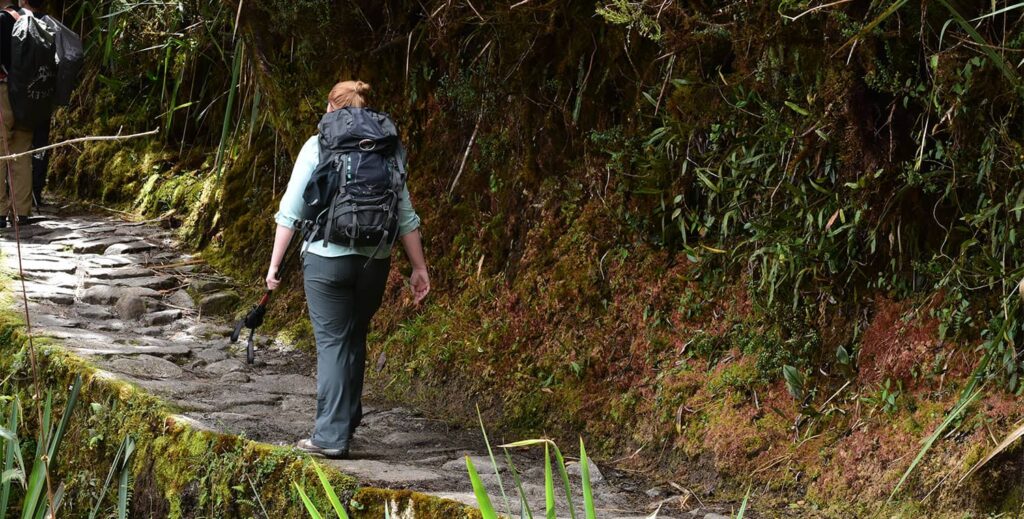
Day 2 is all about conquering challenges and soaking up incredible landscapes!
We’ll share breakfast before readying ourselves to trek towards the legendary Dead Woman’s Pass.
The first two hours of this walk will take you through the lush cloud forest – keep an eye out for unique plants, colorful birds, and maybe even a White-Tailed Deer if you’re lucky!
We’ll take a quick break at Lluchapampa (the last spot to stock up on supplies), before it’s time to tackle Warmiwañusca, or Dead Woman’s Pass.
This two-hour climb rewards you with breathtaking mountain views. The Quechua word “Warmi Wañusqa” means “dead woman”, and they say the mountains ahead look like a woman lying down, gazing up at the sky. Hence the name!
After kicking that challenge’s butt, we’ll press on over Runcuraccay Pass. And the reward?
Lunch at Pacaymayu camp before we get ready for the next ascent!
It’s about 45 minutes to the Inca site of Runcuraccay, and another hour uphill to the Runcuraccay pass. It’s an easy, flat-out gorgeous hike surrounded by towering, snow-capped peaks that’ll take your breath away.
After a well-deserved 90-minute descent, you’ll reach the Inca site of Sayacamarca – the perfect place to catch a stunning Aobamba Valley sunset.
The day ends at the Chaquicocha campsite, a peaceful place to rest your legs and prepare for another day of adventure!
- Meals: Breakfast/Lunch/Dinner
- Accommodations: Camping
- Maximum altitude: 4215 m/13,825 ft
- Minimum altitude: 3,300 m/10,824 ft
- Distance to walk: 16 km/ 10 miles
- Approximate walking time: 8-9 hours
- Area: Andes and Cloud Forest
- Difficulty: Challenging
Day 3: Chaquicocha – Phuyupatamarca – Wiñay Wayna
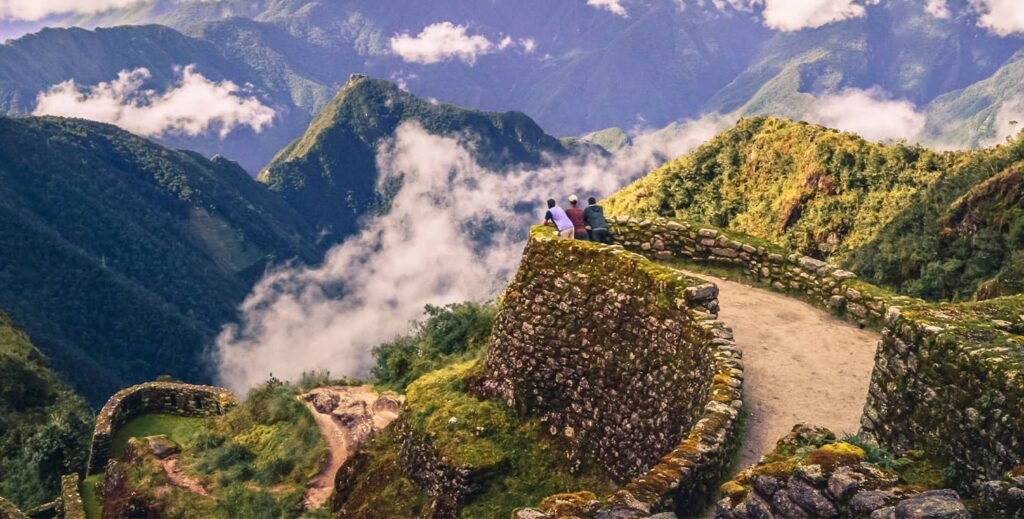
Day 3 starts with a journey back in time and breathtaking landscapes.
Today, we’re going for a 2-hour hike to the Inca ruins of Phuyupatamarca. Catch your breath and get ready for a view you won’t forget: you’ll lay your eyes on all three – Aguas Calientes, Machu Picchu Mountain, and Huayna Picchu Mountain today!
Your guide will talk to you a little about the secrets of these ruins, before it’s time to descend into the lush rainforest.
It’s a 2.5-hour trek downhill that brings you to Inti Pata, a spot many consider the most beautiful on the entire Inca Trail. Just 40 minutes ahead lies your haven: the Wiñay Wayna campsite.
After a well-deserved lunch and some rest, you’ll explore the incredible ruins that give the campsite its name.
Wiñay Wayna, which means “forever young” in Quechua, is the largest and most impressive archaeological site along the Inca Trail. Prepare to be amazed!
- Meals: Breakfast/Lunch/Dinner
- Accommodations: Camping
- Maximum altitude: 3600 m/11,808 ft
- Minimum altitude: 2,680 m/8,792 ft
- Distance to walk: 10 km/6.2 miles
- Approximate walking time: 6 hours
- Area: High Cloud Forest
- Difficulty: Easy
Day 4: Wiñay Wayna – Sun Gate – Machu Picchu – Cusco
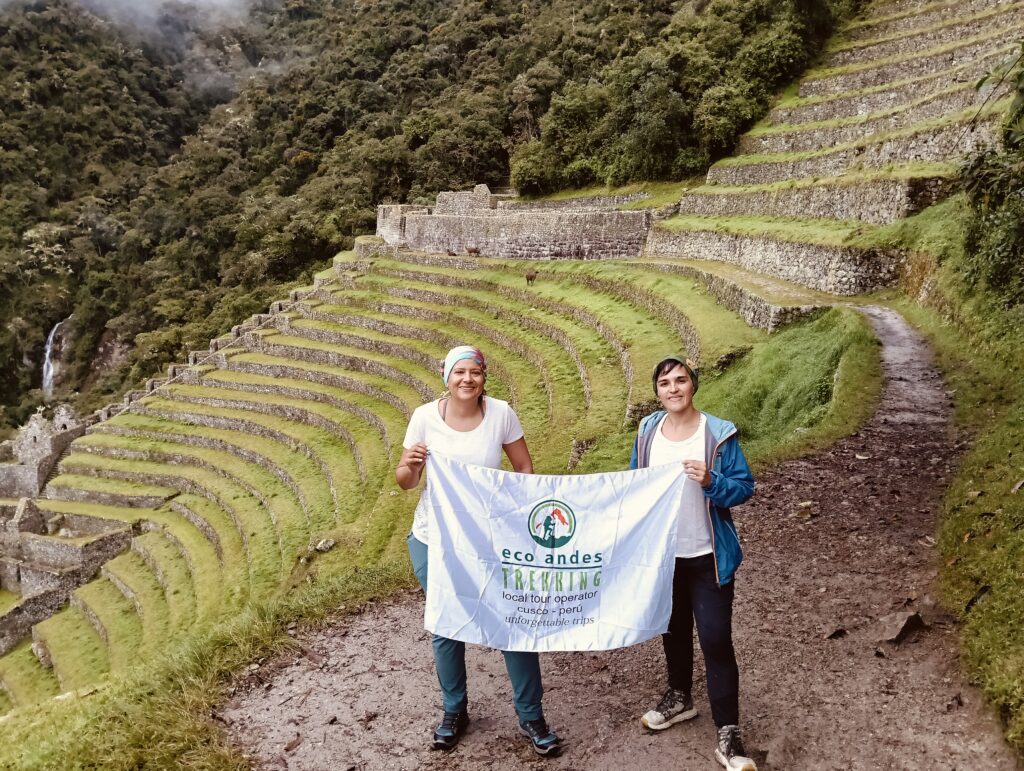
We’ll rise and shine extra early to tackle those last few kilometers of the epic Inca Trail.
After fueling up with breakfast, it’s an easy hour of trekking that leads straight to the legendary Inti Punku – the Sun Gate! This ancient entrance gives you your first jaw-dropping view of Machu Picchu, and if the weather’s in your favor, a spectacular Andean sunrise.
One last 45-minute downhill hike brings you to the city gates, and you’ve made it!
First things first: pictures! We’ll take time to strike a pose at the classic photo spot, then enjoy a well-earned break before the magic starts.
This will be followed by a 2-hour guided tour of Machu Picchu, led by an expert ready to spill all its secrets and legends—a place where history truly comes alive!
Afterwards, it’s time to head back down to Aguas Calientes by bus, then catch the train to Poroy or Ollantaytambo. Don’t worry; private transport will be waiting to whisk you back to your hotel in Cusco.
You’ll arrive sometime around 8 pm, marking the end of your incredible 4-day Classic Inca Trail journey!
- Meals: Breakfast
- Maximum altitude: 2700 m/8,856 ft
- Minimum altitude: 2,430 m/7,972 ft
- Distance to walk: 6 km/3.73 miles
- Approximate walking time: 2 hours
Note: This itinerary is subject to change without prior notice according to weather conditions, strikes, roadblocks, or other events which are beyond our control. At Eco Andes Trekking we will always do our best to follow the itinerary as closely as possible of the Classic Inca Trail route.
SERVICES INCLUDED:
Professional Guided Services:
- Expertly trained and licensed guide fluent in English, Spanish, and Quechua.
- A personal porter dedicated to this iconic Inca Trail trek, with a capacity of carrying 6 kg (13 pounds) of your personal belongings.
Preparation and Support:
- Comprehensive pre-trek briefing conducted 1 to 2 days before embarking on the journey.
- A proficient support team, including professional cooks and porters, responsible for carrying all group equipment and ensuring each hiker’s load does not exceed 6 kg (13 pounds).
Nutritious Meals:
- Three wholesome breakfasts, three satisfying lunches, and three delightful dinners to keep you energized throughout the adventure.
- Ample drinking water and snacks to keep you hydrated and fuelled.
Comfort and Convenience:
- A well-equipped dining tent complete with tables, stools, and all necessary dining utensils.
- A portable Eco-friendly toilet set up at each camp (based on campground capacity).
- A private toilet tent for your convenience.
- A dedicated kitchen tent to prepare delicious meals.
Restful Nights:
- Comfortable sleeping tents and air mattresses provided, with a four-person tent allocated for every two individuals.
Safety and Emergency Preparedness:
- Essential emergency supplies, including a comprehensive first aid kit, oxygen for high-altitude situations, and emergency radios for communication.
Entrance and Transportation:
- Inclusion of all group fees, encompassing Inca Trail permits and entrance to the awe-inspiring Machu Picchu.
- A return train ticket from Aguas Calientes to either Ollantaytambo or Poroy for your convenience.
- All transfers catered for, including a private van ride to the trailhead at KM 82, a bus journey from Machu Picchu to Aguas Calientes, and a private van transfer from Ollantaytambo to your Cusco hotel.
SERVICES NOT INCLUDED:
- Sleeping Bag: Available for rent at USD $30 per person.
- Hiking Poles: Can be rented at USD $25 per pair and per person.
- Huayna Picchu MountainTicket: An optional excursion at USD $75 per person.
- Meals: Breakfast on Day 1 and lunch and dinner on Day 4 are not covered.
- Gratuity: Tips for porters, chef, and guide are not included (see our tipping guidelines)
- Safety Net: We highly recommend obtaining travel insurance.
Items to bring with you:
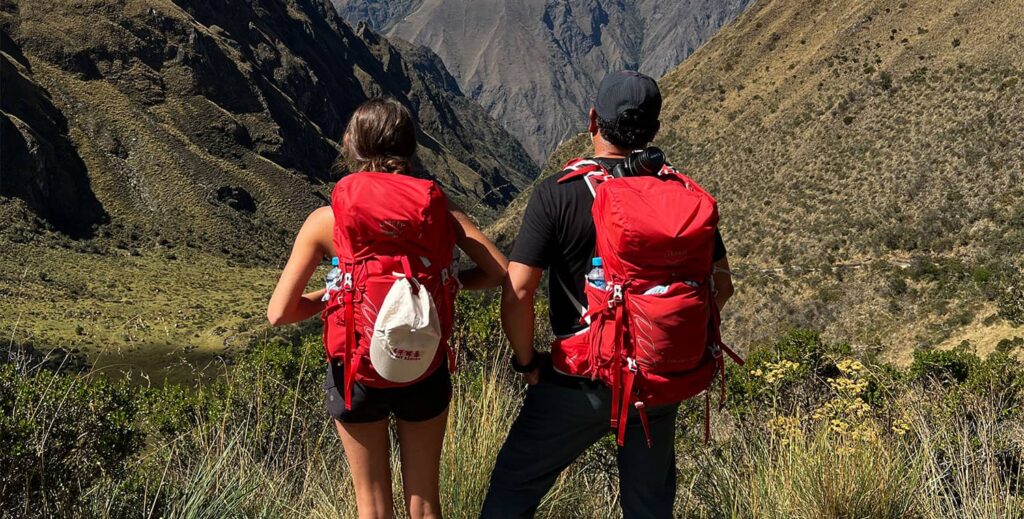
- Original passport (if you have acquired a new one after you made your booking, bring both)
- Down or synthetic feather sleeping bag (can be rented from us)
- Clothes (trekking boots, warm fleece jacket, a few T-shirts, socks, sun hat, warm underwear, light long pants, gloves, rain jacket)
- Toiletries (toilet paper, wet wipes, personal towel)
- Sun protection; Sunscreen (SPF 35+ recommended), sunscreen
- Headlamp, batteries*
- Camera with spare batteries*
- Binoculars
- Book to read (you will have some spare time at every camp)
- Trekking poles (recommended especially for the steep descents, can be rented from us)
- Bug repellent
- NOTE: *Batteries run down faster at high altitudes
PRICES & ADD-ONS
Group: USD $795 per person
Private: USD $895 per person
Group versus Private Treks: What’s the difference?
- Depending on the number of people in your booking, additional people may join the trek to make a full group.
- If you choose “private”, no additional people will be joining your group, no matter the size.
- Minimum booking size is two people; one person may book a group trek if Eco Andes Trekking is able to join that person with additional groups.
Discounts
- Under 18 years Discount: USD $20
- Under 7 years Discount: USD $35
Rentals
- Hiking poles – USD $25 (pair) per person
- Sleeping bag – USD $30 per person
Upgrades
- Return Vistadome train – USD $60 per person
- Return Hiram Bingham train– USD $500 per person
- Private Tent – USD $40 per person
CLASSIC INCA TRAIL 2025 FAQs.
What is the Inca Trail Trek?
The Inca Trail Trek is a famous hiking experience that winds through original Inca pathways, varied scenery, spectacular Inca ruins, ending at the Inca Citadel of Machu Picchu.
How difficult is the Inca Trail?
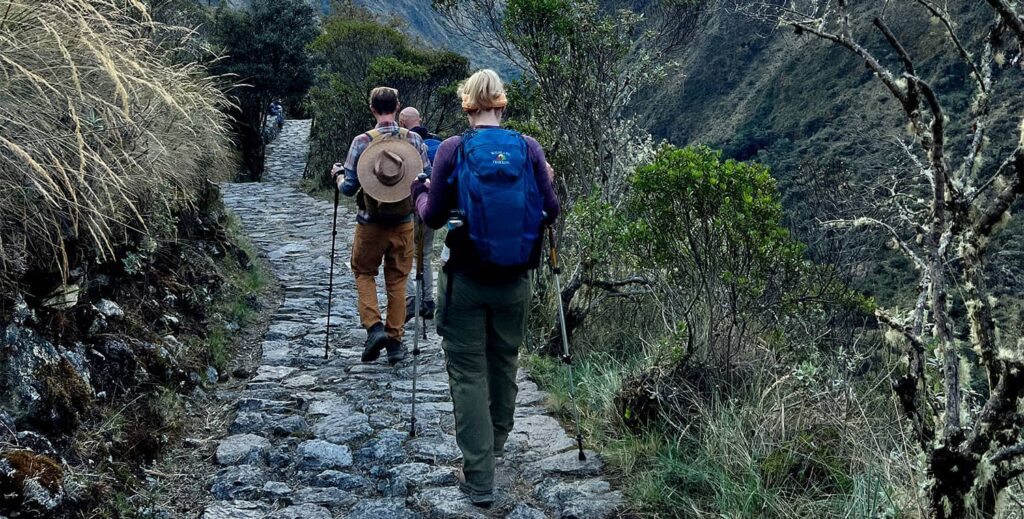
The first day of the trek is moderate, traversing Andean mountain terrain. Day two is the hardest, crossing two high mountain passes. The final day is easier, moving mostly through flat terrain and descent paths.
What if I have dietary restrictions or allergies?
When booking, please mention your specific dietary needs or allergies, and our professional chefs will tailor your meals accordingly. We’ll make sure you get the needed energy for your adventure!
How do I prepare for the Trek?
On top of the standard fitness and preparation necessary for any trek, it’s recommended to attend the pre-trek briefing scheduled for the day before the trek starts in Cusco.
What’s the best time to trek the Inca Trail?
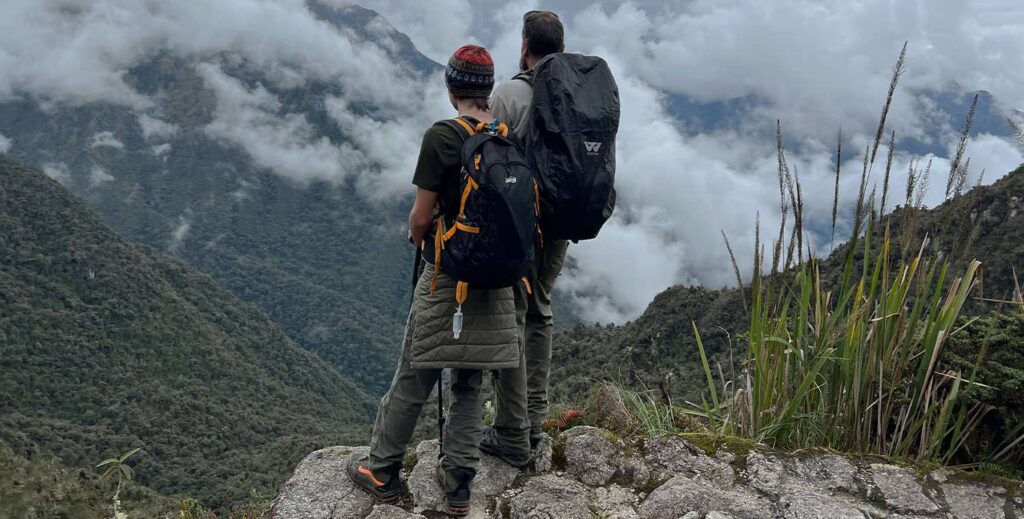
The 4-day/3-night Inca Trail operates year-round, excluding February, when trail maintenance occurs. It’s recommended to book early, as permits are limited and often sell rapidly.
Why is the Inca Trail popular?
The Trail is a microcosm; lush green cloud forest alive with birds, Andean peaks and steep mountain passes, a landscape dotted with centuries old Inca ruins, accessible only to those that follow this most famous pathway.
However, as truly beautiful as the hike may be, the real reason for its popularity lies at the very end of this four-day adventure; passing through the famous Sun Gate for that first magical sighting of Machu Picchu in the distance.
Only Inca Trail hikers can access the gate early in the morning, and it is this crescendo, at one of the new seven wonders of the world which makes this hike a feature on so many ‘South America bucket lists’.
The Inca Trail is the best way to arrive at one of the world’s most iconic attractions ” See here reason why you should hike the Inka Trail“.
When should I reserve an Inca Trail permit for my hike?
Everyone should book their Inca Trail permit as far in advance as possible. The Inca trail permits are in super high demand as they do offer access to one of the top hiking trails on the planet!
It’s very common that permits for certain months of the year to sell out completely for the upcoming season in just a matter of days or hours.
On top of that, permits are non-refundable or transferable, so if any hikers who have purchased permits subsequently cancel them, they won’t become available again at a later date in the government system.
The Peruvian government releases all the permits in bulk throughout the month of October for the upcoming year. For example, for a hike in 2025, you can expect permits to be released in October 2024.
The best way to ensure you’re in the running for your chosen trek date is to have your Inca Trail pre-booked for the upcoming year before the permits are released in October 2024.
A general rule to follow is to book permits for the Inca Trail at least six to eight months in advance to ensure trail availability for treks on the traditional Inka Trail route.
Although 500 Inca Trail permits are available each day (Inca Trail availability in real time), around 300 of those are allocated to porters and guides, so in reality there are really only 200 permits a day for hikers.
How many Inca Trail permits are issued per day?
The number of permits for the Inca Trail offered was cut back in 2005, so that there’s now only 500 up for grabs each day.
To put that into perspective, that’s around a third of the 1,500 people and porters who were estimated to have hiked the trail prior to the start of restrictions in 2002. So, it’s hardly a surprise that there’s always a scramble to get permits!
To make matters worse, a majority of the 500 permits that are issued daily are set aside for guides, porters, and cooks.
Roughly 300 Inca Trail permits go to the support teams, leaving limited trail availability, allowing only 200 for travelers looking to get on the Inca Trail to Machu Picchu.
There is some good news. The Peruvian government recently added another extra 250 permits for sole use on the Short Inca Trail hike. The 2-day short Inca Trail is essentially the final day of the traditional four day Inca Trail route with some variations in the beginning of the hike.
Permits for the Short Inca Trail hike is in far less demand, but it has helped to free up the entire batch of original permits for trekkers eager to commit to the traditional 4-day Inca Trail.
Note: Once the permit has been issued, you can not alter or change any details, so be sure you get them correct from the start.
Does the Inca Trail trip include your Machu Picchu entrance ticket?
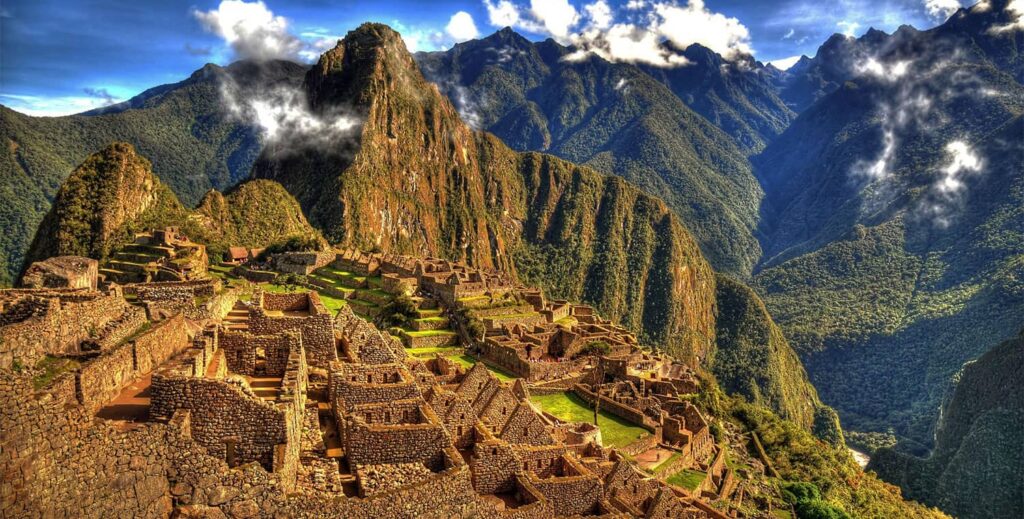
Yep, the cost of entry is included in the trip price and it’s the responsibility of the tour company to take care of all that and provide you with the ticket on the day you’re entering the site.
Is there a waiting list for sold out trekking dates?
No, there is no waiting list for permits. Permits are only available for purchase through the Peruvian government.
Once a permit is purchased for one person, the permit cannot be refundable or transferred to another individual.
Where do I store my luggage during our Classic Inca Trail to Machu Picchu 4 days Trek?
Your Cusco hotel will store your luggage for free while you will be on the trek. We can also store your extra luggage at our office in Cusco if needed.
Are Inca Trail permits sold out for your preferred departure dates? Or maybe you would rather take a longer or shorter trek or a path less beaten?
If this is the case, you have plenty of options for hiking in the Peruvian Andes!
Salkantay Trek
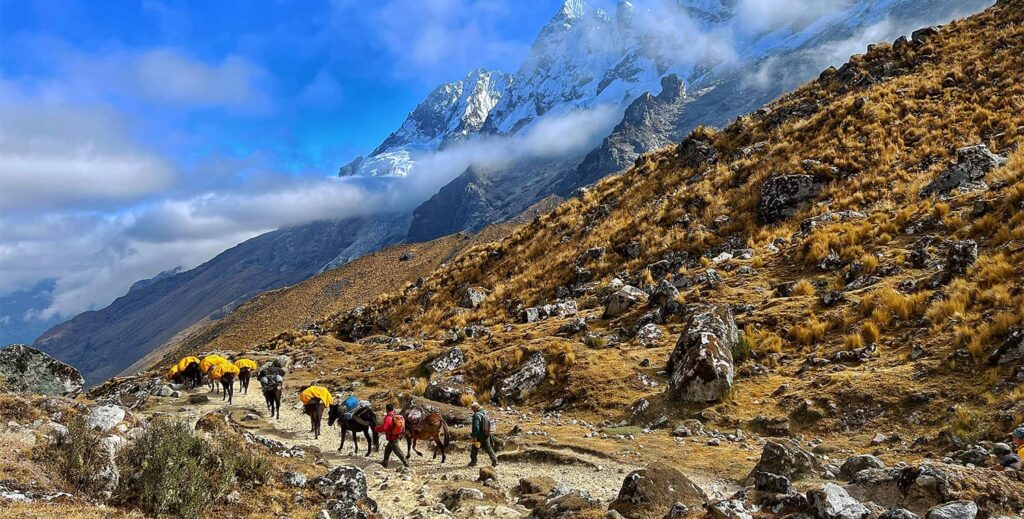
The Salkantay trek is offered in both 4 and 5 day versions. The route is the same for both, it is just a matter of how many kilometers you hike each day.
It is the most popular alternative trek to the traditional Inca Trail. It features diverse ecosystems including cloud forest, rain forest and high mountain.
You will have stunning views of snowcapped glaciers and a strikingly blue lake. The Salkantay route meets up with an ancient Inca highway that leads to the recently rediscovered ruins of Llactapata.
From there, one can gaze a few miles across the valley to take in a rare sidelong view of the full Machu Picchu complex and Huayna Picchu mountain.
A downhill walk ends at the small train station, where a 3 PM train runs along the Urubamba River to Aguas Calientes, the town at the base of Machu Picchu.
Salkantay Trek with Zip Line, There is the option with the Salkantay Trek to do the Zip Line in Santa Teresa, a thrilling experience. You also have the option of visiting the Santa Teresa Hot Springs. These are definitely the nicest hot springs in Peru.
- Trip Length: 5 to 8 days
- Difficulty Level: Medium to difficult
Ancascocha Trek
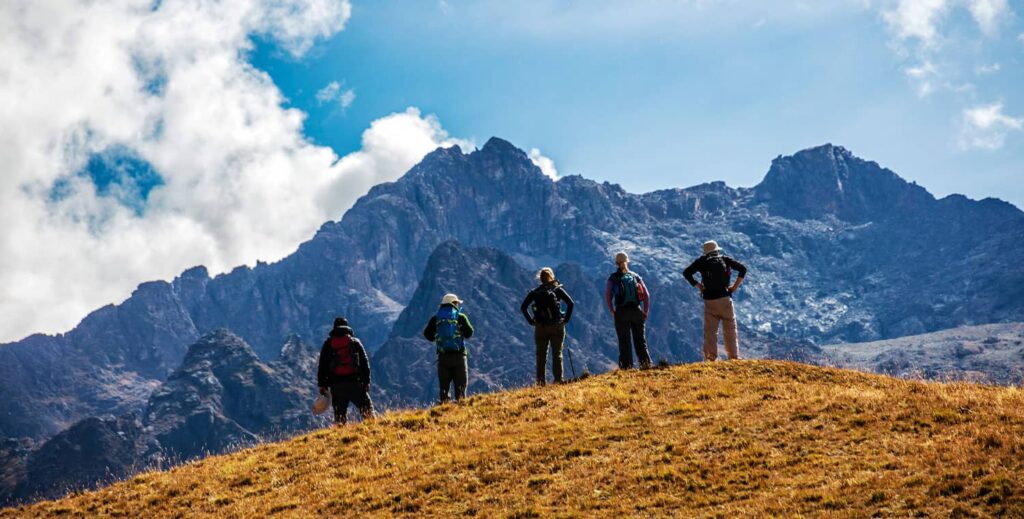
The Ancascocha Trek is unique and the scenery is mind blowing! You will rarely see any other trekkers on this trek.
The Ancascocha Trek to Machu Picchu is available in both 4 and 5 day versions. The route is the same and the difference is in distance hiked per day. This is our signature trek.
We are one of the few companies that offer it. Due to this, we are usually the only company at the camps. There are red mountains, stretches of original Inca paths, blue lakes, glaciers and much more.
This trek has 4 Inca ruins, and you also walk a portion of the four day Classic Inca Trail on day 4 or 3 down to Kilometer 82 (start of the 4 day Inca Trail).
On day 1 of the hike, you visit the Perolniyoc ruins and have a full guided tour. On the fourth or fifth day you visit and tour three Inca sites.
All three are closely coordinated with the Inca Trail. These are Paucarcancha, Llactapata (first Inca site on the 4 day Classic Inca Trail), and Willka Raqay.
You will also get an opportunity to observe the ruins at Ollantaytambo, but will not have time for a visit since you will have to catch the train to Aguas Calientes!
- Trip Length: 4 to 8 days
- Difficulty Level: Medium to difficult.
Lares Trek to Machu Picchu
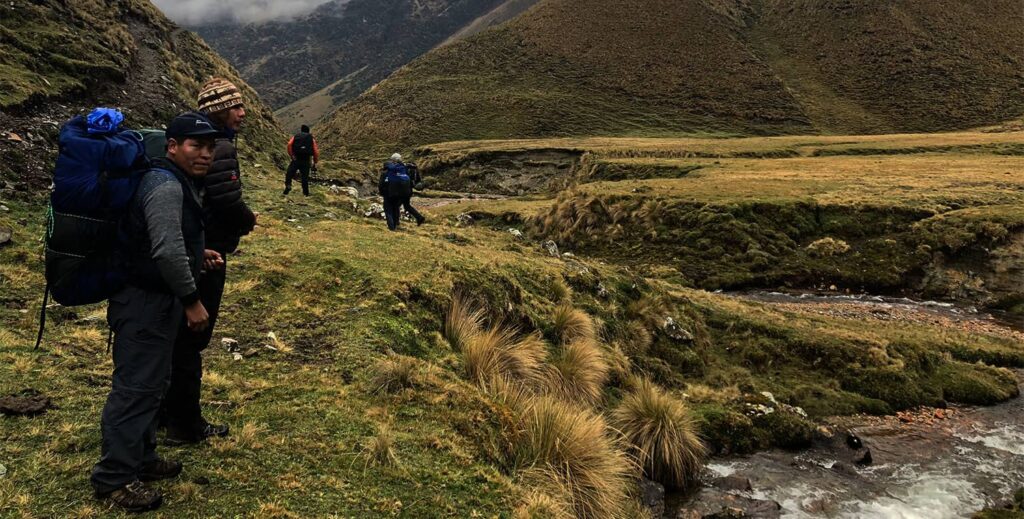
This 3-day trek traverses highland communities, renowned for their handwoven textiles, in the Lares Valley.
This trek is off the beaten path and the interaction with local villages and their vibrant cultures is superb. You will see abundant llamas and alpacas.
The Lares trek is also referred to as the Weaver´s Trek. This is because you pass through many villages where the best textiles in the area are made.
You will see the women weaving and get some tips! You also get to visit the magnificent Lares hot springs. It ends at the town of Ollantaytambo, and from there the train trip to Machu Picchu is only 1 ½ hours.
- Trip Length: 3 to 5 days
- Difficulty Level: Medium
Short Inca Trail to Machu Picchu
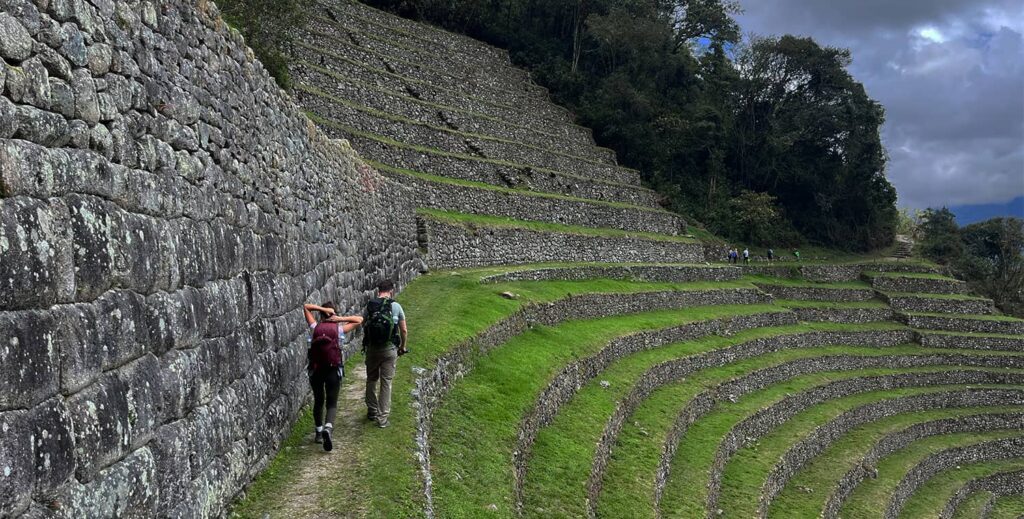
The Short Inca Trail is ideal for travelers who have limited time or want something less strenuous.
This hike starts at KM 104 of the Machu Picchu train line on a trail that leads to two archaeological sites Chachabamba and Wiñay Wayna. This hike also gives you the opportunity to enter the lost city via the famous Sun Gate, the dramatic entrance that provides Inca Trail trekkers with their first glimpse of the site.
Spend the night in Aguas Calientes and then wake up on Day 2 for a Machu Picchu tour.
- Trip Length: 2 days
- Difficulty Level: Easy to Medium
The Inca Quarry Trail
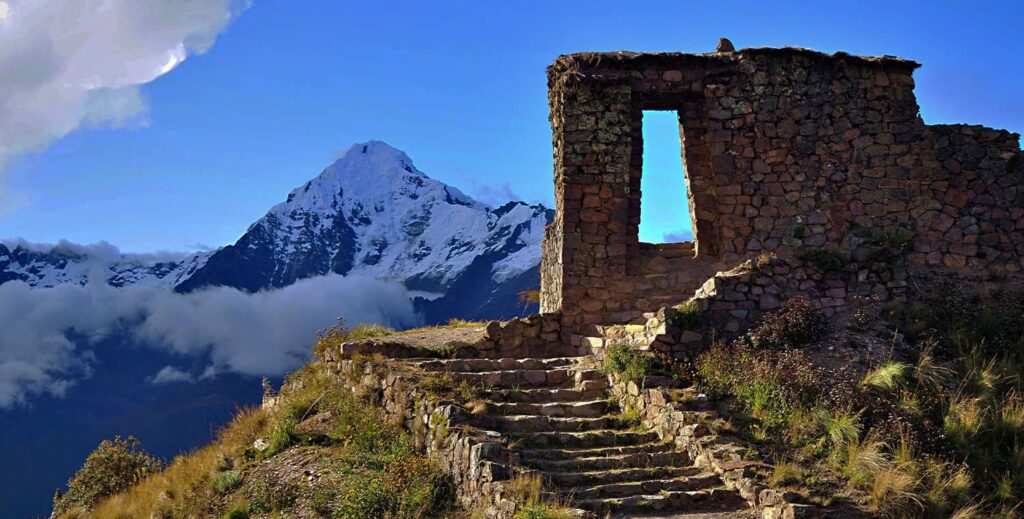
The outposts of the vast Inca Empire were kept connected by fleet-footed chaski messengers, who ran so fast that the emperor was able to dine in Cusco on fresh fish from the Pacific Ocean, a mountainous 300 miles away.
This high-altitude route follows some of the same paths those runners might have used, and takes in scarcely visited Inca buildings, water channels, and quarries, where one can see firsthand how the Inca obtained the stone, they used in their building projects.
The Inca Quarry Trail includes a stop at the spectacular waterfall named Perolniyoc and its nearby ruins.
The trail ends at Ollantaytambo, where trekkers can visit one of the most famous sets of Inca ruins before hopping the train to Aguas Calientes, the nearest town to Machu Picchu where you spend the night in a hotel before you visit Machu Picchu in the final day of your 4-day trip.
- Trip Length: 4 days
- Difficulty Level: Medium
Can you hike the Inca Trail without a tour guide?
Since June 2002 trekking independently on the Inca Trail has been prohibited. Access to the Inca Trail is strictly controlled by the Peruvian government and your trek must be organized through a tour operator.
Only specific licensed companies like Eco Andes Trekking are permitted to lead groups on the 5-day Inca Trail, 4-day Inca Trail and 2-day Inca Trail routes.
Companies must meet certain basic requirements proving that they have professional guides and good camping equipment, radio communications and emergency first aid including oxygen. Their license is renewed each year.
Can I use a different name to hike the Inca Trail?
No, you need to carry your valid ID (passport) to enter the trek park.
What is the terrain like? And how difficult is the Inca Trail hike?
It’s not our most challenging trek, but you will be walking over hilly and rugged terrain with lots of stairs.
Expect some long, steep ascents too. Most of the hiking is on fairly well-defined tracks, including some remarkable sections of ancient Inca stone “highways”.
The entire 4-day trail hike is 28 miles so the distances traveled each day are not terribly long.
Although it is generally accepted that anyone who is accustomed to hiking and camping (i.e., walking for several hours and sleeping in tents) can hike the Inca Trail, the altitude can make hiking these distances feel about twice as difficult as hiking the same distance at sea level.
With the help of porters carrying your personal gear (6kg per hiker), you’ll only need to worry about carrying a day pack of around 4 kg including your water, camera and clothing layers.
Which campsites do you use along the Inca Trail?
Campsites may change depending on booking time and availability, weather conditions or on restrictions undertaken for safety reasons by the Peruvian Government.
We generally try to camp in less trafficked areas so that trekkers can enjoy the natural beauty of the Inca Trail and minimize environmental impacts.
Our regular campsite choice is Ayapata, Chaquicocha and Wiñay Wayna (campsites are subject to availability).
What do I need to carry on the trek?
We recommend that travelers carry the items that they will need each day while hiking such as water, snacks, camera and film. Our porters will carry 6 kg of each of your personal gear including the camping equipment during the trek.
We will give you a duffel bag for those belongings at the time of your pre trek briefing.
We generally ask trekkers to bring only the necessary items that they will need for the trail and leave any unneeded luggage at the hotel in Cusco or at our office.
How big are the groups?
Our groups are usually small. Average is 3 to 5 people and maximum 16 people plus the trekking team.
What is the best time of year to hike the Inca Trail trek?
The best time to hike the Inca Trail is during the dry season – generally May to October. The rainy season comes on slowly in November and December and is at its strongest from January through early April.
Of course, the flora surrounding the trail and among the ruins themselves will be at its greenest during and just after the rains.
So May, June, July and August are the most popular months as folks take advantage of the combination of drier weather with the greener hillsides.
Is the Inca Trail to Machu Picchu always open?
The Inca Trail is open 11 months of the year (March through January). It is closed every February for maintenance.
Are there toilets and showers at the campsites?
Some campsites have on-site toilets and showers; however, these are not well maintained. Instead, your trekking team will bring a toilet tent and portable toilet that will be set up during lunch and at each campsite with the exception of Wiñay Wayna. See here Our Trekking Gear.
As there are no toilets mid-trek, you opt to wait until lunch or to reach the campsite or to go in nature. Each morning and night you will also be provided a bowl of warm water with which to freshen up.
What is the elevation of the 4 day Inca Trail?
The 4-day Inca Trail begins at Km 82 which has an elevation of (2,400 m / 7,872 ft).
The highest point is Dead Woman’s Pass at (4,215 m /13,825 ft) and the lowest point is Machu Picchu at (2,430 m /7,972 ft).
What is the food like on the Inca Trail trek?
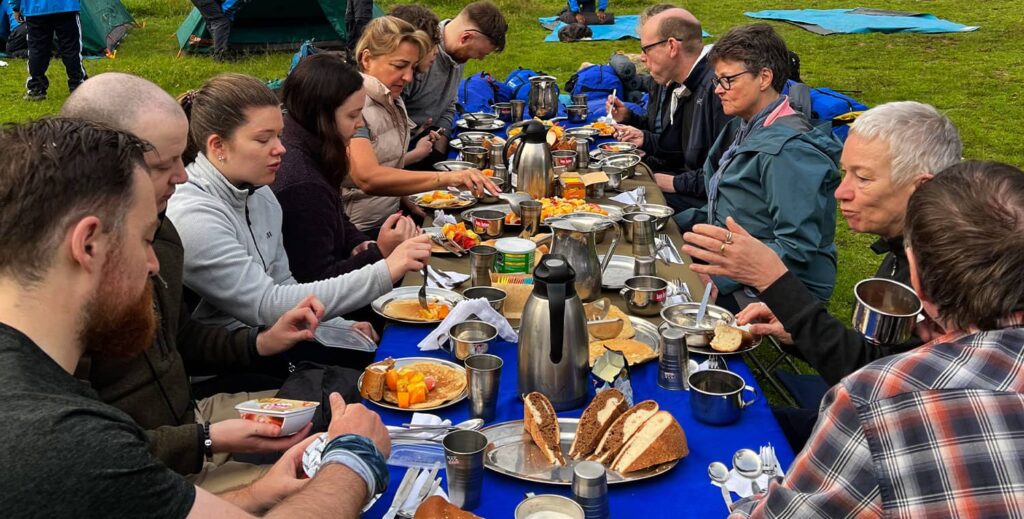
A cook accompanies each group on the Inca Trail and prepares breakfast, three course lunches and dinners.
The meals are quite exquisite considering that all of the ingredients and cooking supplies are carried from. Cusco and the Sacred Valley.
Each trekker is also provided with snacks to take with them on the trail. Vegetarian and vegan meals are also available upon request.
Other special dietary requests can usually be accommodated as well with sufficient notice.
Here is a the Food on our treks.
Is drinking water supplied?
Yes, our trekking team will provide drinking water every morning and at each meal.
Each evening, water is collected from nearby streams, boiled, and left to cool overnight.
A reusable water bottle or hydration pack works well for this. We recommend that travelers bring their own refillable bottles to limit plastic waste along the Trail.
What equipment is supplied by us along the trip?
We supply the sleeping tents (4 person tents for two travelers), dining tents, tables, chairs, toilet tents, cooking equipment, water purifiers, Therma-rest air sleeping pads, and other camping equipment.
Our outfitter purchases the highest quality equipment in Peru and older equipment is evaluated and replaced on a regular basis.
What are the guides like?
Our team are among the very best and most experienced guides anywhere.
They are from the surrounding Cusco and the Sacred Valley areas and speak fluent English, in addition to Spanish and the Inca indigenous language of Quechua.
Most have 8-10 years of experience leading Inca trail hikes and other alternative treks and all have training in the history, spirituality, culture, and ecology of the area.
How can I be sure that the porters are well-cared for?
EAT ensures proper staffing, have weight limits for our Amazing Porters, and support fair wages.
Most of our porters come from villages in the Sacred Valley. Some of these include Lares and Patacancha communities.
We have a long and successful relationship with the people of these villages and frequently contribute to the needs of the community through donations, community service and etc.
How to prepare for an Inca Trail hike:
The more training you do beforehand, the more you will enjoy your trek.
We recommend 30 minutes of cardio activities 3-4 times a week in the 2-3 months leading up to your departure. Take every opportunity to walk up and down stairs or hills for leg strengthening and aerobic fitness.
4-day vs 2-day Inca Trail Trek
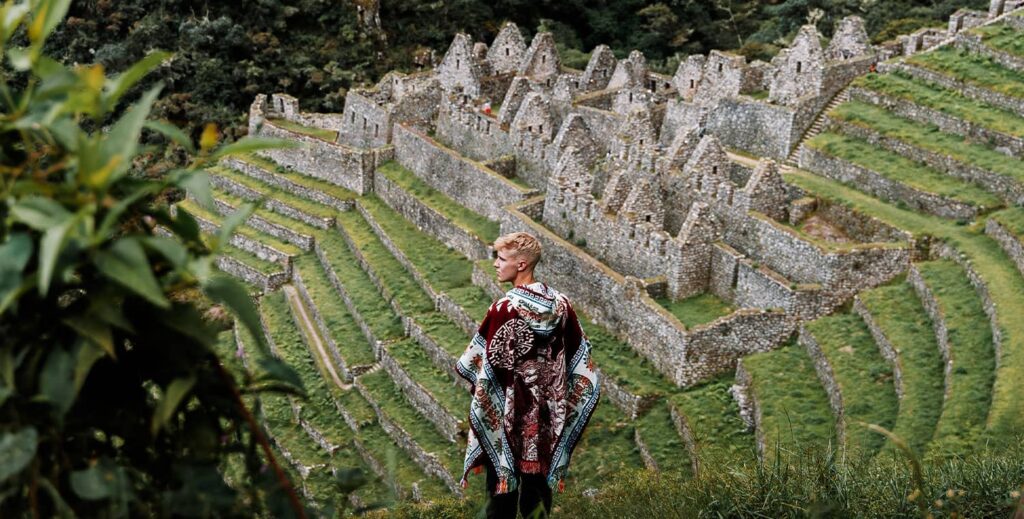
In addition to the 4-day Inca Trail trek, there is a shorter full-day hike.
Despite only including one day of hiking, this shorter hike is referred to as the “2-day Short Inca Trail” because the hike to Machu Picchu is on Day 1 and the Machu Picchu tour is on Day 2.
Both the 4-day and 2-day Inca Trail treks have distinct advantages and disadvantages.
The 4-day Inca Trail trek is ideal for travelers looking for a physically challenging adventure. Four days of trekking through a variety of landscapes is a great way of getting to know this part of the Andes.
While the trekking team makes the experience very comfortable, three nights camping in a tent is perhaps not for everyone.
Alternatively, the 2-day Short Inca Trail is recommended for travelers who cannot or do not wish to devote four days of trekking to their trip, but would still like to experience the Inca Trail.
This Short hike additionally permits hikers to enter Machu Picchu through the famous sun gate which is the main entry to Machu Picchu via the iconic Inca Trail.
The 2-day Inca Trail is particularly popular with families that enjoy hiking and are looking for a taste of adventure.
There is camping option involved with this trip and as wells as travelers can choose to spend the night in a hotel after hiking to Machu Picchu on day one.
Are there any ATMs?
There are no ATMs along the Inca Trail. You should bring enough money with you from Cusco for tipping and lunch in Aguas Calientes.
There are also some ATMs in Aguas Calientes if you need to withdraw additional cash.
What if I have a medical emergency while hiking the Inca Trail?
Guides carry a first aid kit for basic medical problems (traveler’s diarrhea, cuts/scrapes, etc.).
They receive Red Cross First Aid and other emergency training every year.
Our guides lead over 1000 travelers along the Inca trail each year and we have rarely had a traveler unable to complete the hike.
In these rare instances when someone has not felt well enough to finish the hike, he/ she has been escorted back to Ollantaytambo or to Cusco and generally felt well enough to re-join the group in Machu Picchu via train a few days later. Cusco and the Sacred valley have the nearest modern medical facilities so travelers with a serious medical emergency would need to be evacuated there.
Guides and porters have pre-established evacuation strategies in place should this need occur.
Is there internet access on the Inca Trail?
Nope, and this is one of the best things about it.
Instead, you and your group will spend evening conversing over plastic cups of hot tea, playing card games, or lazing in nature together.
Your last chance to use the internet or have a reliable phone signal will be in Ollantaytambo (the town before KM 82), and your first opportunity will be at Machu Picchu or in Aguas Calientes.
How much money should you bring on the Inca Trail?
The vast majority of costs will be covered in the up-front price of your trip, but there are a few costs along the way for which you’ll need to bring cash:
- Snacks and drinks from stallholders
- Toilet entry fees (usually 2 soles at Machu Picchu)
- Tips for porters and guides
- Lunch on day 4 at Aguas Calientes.
It’s sensible to take this money in the form of smaller notes and coins.
We’d say at least 350 soles per person for the Trail-specific section.
Will I get altitude sickness on the Inca Trail?
Many of the most popular places in Peru, such as Cusco and Huaraz, are at high altitude; this means that for anyone planning a trip to Peru understanding altitude sickness (and how to avoid it) is incredibly important.
In fact, not approaching altitude correctly is one of the biggest mistakes of travelers in South America.
The best way to minimize the likelihood and impact of altitude sickness is factoring in enough time into your Peru itinerary to acclimatize to the conditions.
This means that it is incredibly foolish to arrive in Cusco, which is at 3,339m (11,151 feet) above sea-level, and leave the next day to do a strenuous hike or even start the Inca Trail. Your body needs the time to adjust to the altitude!
A good rule of thumb is to give yourself and your body two easy days at altitude to acclimatize to the change, and to keep yourself well hydrated throughout.
What about medication?
Obviously, medical attention and facilities along the Inca Trail are pretty much non-existent so you need to bring any of your own required medication with you and keep it on your own person or in the daypack.
What climates can I expect on the Inca Trail?
Variance in latitude, elevation and local winds all factor into the wide range of climates experienced in the central Sierra/Andean Mountain region.
Average temperatures in the Sierra vary little between seasons, but there is dramatic daily variance.
While the average daily temperature may only vary a few degrees Celsius between January and July, the diurnal (daily) temperature range is often huge.
You can expect daytime temperatures in the highlands to be in the range of 10-25°C (50-77 °F), falling as low as -10 °C (14°F) at night.
How long can I stay at the Machu Picchu sanctuary?
There are three time slots in which patrons can enter Machu Picchu for a maximum of four hours and must follow one of three predetermined routes. Admission is not allowed after 4pm. Additionally, all visitors must always be accompanied by a guide.
The early morning is one of the best times to savour the views and atmosphere of Machu Picchu. The mystical morning light over the enigmatic sites is spectacular.
Try and catch the sunrise at the sanctuary, you won’t regret the early wakeup call!
Eco Andes Trekking is rated highly on TripAdvisor. Our reputation echoes through hundreds of elated trekkers. The praise from our travelers propels us to continually refine our offerings, ensuring an exceptional journey for every adventurer.
PRICE PER PERSON IN USD:
Group: $ 550
Private: $ 600
DURATION:
2 Days / 1Night
AVAILABLE ADD-ONS
- Hiking Pole (pair) – USD: $10 per person
- Return Vistadome Train per person – USD: $60 per person
- Return Hiram Bingham train per person – USD: $420 per person
- Sumaq Machu Picchu hotel (5-star hotel) – USD: $255 per person per night (double occupancy)
- Inkaterra Machu Picchu El Pueblo hotel (5-star hotel) – USD: $250 per person per night (double occupancy)
- El Mapi Hotel by Inkaterra (4 star hotel) – USD: $115 Per person per night (double occupancy)
- Tierra viva Machu Picchu (3+ star hotel) – USD: $50 per person per night (double occupancy)
- Huayna Picchu Permit – USD: $75 per person
- Single Hotel Room – USD $45 per person
OVERVIEW
- Duration: 2 Days, 1 Night
- Day 1: Cusco – Chachabamba – Wiñay Wayna – Sun Gate – Machu Picchu – Aguas Calientes
- Day 2: Aguas Calientes – Machu Picchu – Cusco
- Beginning Altitude: 2,170 m / 7,170 ft
- Maximum Altitude: 2,720 m / 8,920 ft
- Hike Total Distance: 13 km / 8 miles
- Overall Trek Difficulty: Average
INQUIRE ABOUT THIS EXPERIENCE
WHY WE'RE DIFFERENT
Your Full Satisfaction or Your Money Back
We understand planning a big trip like ours at EAT takes a lot of trust, and we’re here to make sure that trust pays off from the moment you book to the day your adventure wraps up. We’re fully committed to making your experience unforgettable. If something doesn’t go as planned—whether it’s an issue with the service or something unexpected along the way—we’ll step in to fix it.
That even includes offering a refund if needed so you can book with total peace of mind.
Your Peruvian adventure means the world to us, and we’ll go the extra mile to make sure it not only meets but exceeds your expectations. With our satisfaction guarantee, you can relax and focus on taking in all the incredible beauty and culture Peru has to offer.
We Help You Experience Peru Through The Eyes of a Local
We’re 100% locally owned and operated, with guides, porters, and chefs who grew up in the Cusco region. Fluent in Spanish, English, and Quechua, our team brings unmatched cultural and historical knowledge to share with you. Traveling with us means gaining insight into Peru’s traditions, landscapes, and stories from those who know them best.
We Work With Professional Guides Who Provide Exceptional Service
Our guides are the best of the best. Truly skilled experts with at least 5 years of experience, every guide we employ is ready to share their expertise on Peru’s trails, culture, and history. Our porters are no exception. They work hard to make your journey one for the books, while our chefs will prepare you delicious meals along the way. With a 99% recommendation rate, we’re dedicated to making every detail of your trip unforgettable.
We’re Committed to Our Team
Our porters and horsemen are easily the backbone of every trek. That’s why we are fully committed to prioritizing their well-being. We ensure they’re paid above-average wages—higher than those offered by most tour companies—recognizing their hard work and dedication to the team. Beyond fair pay, we truly care for their well-being, providing proper gear, meals, and working conditions so they’re not just safe but comfortable, too.
We Look Out for Our Community
A portion of every trek we sell supports local projects, like helping fund a much-needed school roof in Sacsayhuaman, where many of our team live. For years, children in the area had no nearby school and faced grueling four-hour walks in harsh conditions to get an education. Today, thanks to these contributions, they have a local school, and we continue to donate to its upkeep—because making an impact goes beyond the trek.
We Customize Our Adventures to Suit Your Travel Style
We want every trip to feel like it was made just for you. Whether you’re keen on hiking the famous Inca Trail, exploring lesser-known spots in the Sacred Valley, or tackling our one-of-a-kind Ancashcocha + Inca Trail trek, we’ll plan your adventure to fit your travel style. To keep things personal, we keep group sizes small—and if your group is larger than eight, we’ll bring in an extra guide so no one misses out on the experience.
We Travel with Purpose – Serving the Women, Children, & Men of Peru
Every journey with us has a ripple effect. Your adventure supports ethical tourism, fair wages for porters, and opportunities for female trekkers–many of whom are breaking barriers on the Inca Trail–and children. We’re passionate about creating opportunities for local children to grow up healthy and learn about everything their heart desires. Through initiatives like repairing schools, donating educational materials, and funding projects, we make it a mission to build a brighter future for kids in the Cusco region. Every trek you take with us contributes to this mission. When you book with us, you’re not just exploring Peru; you’re investing in it and setting a standard for all other tourism companies and tourists.
Our Reputation is Built on Trust
Year after year, Eco Andes Trekking has earned top ratings on TripAdvisor and the prestigious Certificate of Excellence. We’ve worked hard for these awards and are proud to see our hard work recognized. Even prouder to know our travelers leave with unforgettable memories and stories worth sharing.
We Travel Sustainably & Responsibly
Peru’s landscapes are magnificent. That’s why we work so hard to protect them. We prioritize sustainable traveling by working with our local communities and employing indigenous guides––thus promoting economic empowerment and preserving cultural heritage. Along the journey, we’ll always encourage travelers to embrace responsible practices as advocates for the environment.
